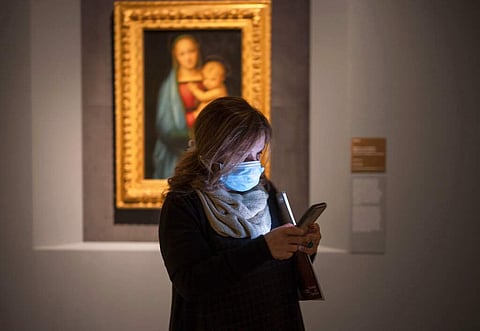
- LIFESTYLE
- FASHION
- FOOD
- ENTERTAINMENT
- EVENTS
- CULTURE
- VIDEOS
- WEB STORIES
- GALLERIES
- GADGETS
- CAR & BIKE
- SOCIETY
- TRAVEL
- NORTH EAST
- INDULGE CONNECT

ROME (AP): The paintings, drawings, tapestries and sketches in the most ambitious exhibition of Renaissance superstar Raphael's works are collectively insured for 4 billion euros ($4.4 billion) against theft, vandalism or other damages.
But no money can guarantee that Italy’s outbreak of coronavirus, the largest in Europe, won’t play havoc with the three-month run in Rome of this year's eagerly-awaited art blockbuster.
Nervousness was palpable at a preview Wednesday that the Italian government's increasingly restrictive measures aimed at containing the outbreak might prematurely shut down the Raffaello exhibition, which is being mounted to mark the 500th anniversary of his death.
The project brings together 120 works by Raphael, including from collections ranging from those of Queen Elizabeth II to some of the world’s most prestigious museums.
Entitled Raffaello 1520-1483, the exhibition opens Thursday in the Scuderie del Quirinale, an 18th-century former stable converted into an elegant palazzo.
There was reason to be nervous. Italy closed all schools and universities Wednesday and barred fans from all sporting events for nearly the next month to try to tamp down the deadliest coronavirus outbreak outside of China. So far, over 3,000 people have been infected in Italy and 107 of them have died.
On April 6, 1520, at the height of a brilliant career as a painter and architect in Rome, Raphael succumbed, on his 37th birthday, to eight days of fever and was buried in Rome's Pantheon.
Some 40 of the paintings and sketches come from the Uffizi Galleries in Florence, whose director, Eike Schmidt, sought to tamp down apprehension about viewing the show.
He stressed that the recommended one-meter (yard) distance between people in public places would be respected to reduce risks of any contagion and hand sanitizers were affixed to exhibit walls.
He was interviewed in front of one of the show’s top draws, Portrait of Pope Leone X. The painting underwent a painstaking, three-year-restoration that enhanced the rich hues of the scarlet cap and cape of the pontiff, one of Raphael’s patrons, and the cardinal-red robes of two cardinals.
So exquisite is Raphael’s detailing that a silver bell near the pontiff’s left-hand looks like you could pick it up and ring it.
Pausing in front of Raphael’s creations – including preparatory sketches as breathtakingly beautiful as the paintings that ensued – viewers feel caught in the gaze of the artists’ subjects.
Schmidt noted that while Michelangelo was “constantly interested in the anatomy of the human body," and Leonardo da Vinci was ”principally interested in the scientific analysis of the world," Raphael's interest “was really the psychology of his sitters" for portraits.
Raphael was intent on exploring "how can you express a human character, a soul, through painting, which is very difficult, if not impossible.”
But, Schmidt added, switching to Raphael's Italian name " if anyone came close to do it, that was Raffaello.”
Drawings, with ink or red or black chalk, provide ample examples of Raphael’s success in infusing human figures with emotion. Two of Raphael’s celebrated portraits have inspired countless musings about the women who posed for a painter known for his lively love life.
One, informally known as Fornarina, or the baker’s daughter, was said to be his mistress and was painted in his last year of life. A finger on her right hand appears to point to a slim armband on her bare arm with the artist’s name. Nearby is Portrait of a woman called ‘La Velata,’ or the veiled woman.
When Italy’s COVID-19 outbreak surfaced last month, more than 70,000 tickets had already been sold for the Raffaello exhibit.
Organizers on Wednesday said “the number of visitors accessing the halls will be controlled” to dilute the risks of any visitors transmitting the new coronavirus.
But if Raffaello was forced to temporarily close its doors or slash entrance numbers, it's highly unlikely that it could be extended.
While the Uffizi has so many Raphael works it could lend 40 and still keep its Raphael room open in the Florence museum, other lending institutions, among them the Prado, the Louvre, the National Gallery in London and the National Gallery of Art in Washington, DC, would be reluctant to deprive for more weeks their own visitors of an opportunity to view their Raphael works in their own collections.
The viral outbreak has already inconvenienced art lovers in Italy.
Last week, admirers of Caravaggio, the Baroque master painter, found themselves locked out of a church in Rome, St Louis of the French, which has three of the painter’s works.
A priest at the church had tested positive for the virus after passing through Italy's north, the heart of the outbreak in Europe. When the church re-opened on Wednesday, several tourists wore face masks.
Earlier in Italy’s outbreak, the government ordered museums in the hard-hit northern regions temporarily closed. When Turin’s renowned Egyptian Museum re-opened this week, director Christian Greco decided to extend its opening hours to better space out visitors.
“The museum is for everyone, and we’re here for them,’’ Greco told state radio Tuesday. The mood among his relieved staff was “happy to come back."
Workers at France's Louvre Museum force shut down over fears of being infected by tourists
New VR exhibit gets viewers eye-to-eye with Martin Luther King Jr in iconic 'I Have a Dream' speech
Mumbai-based artist Biraaj Dodiya to hold debut show, Stone is a Forehead at Experimenter, Kolkata
Report & pics: The late Zaha Hadid's 'exoskeleton' tower is an instant Miami landmark
New NGMA exhibition of paintings, sculptures and prints offers glimpses of post-Independent India